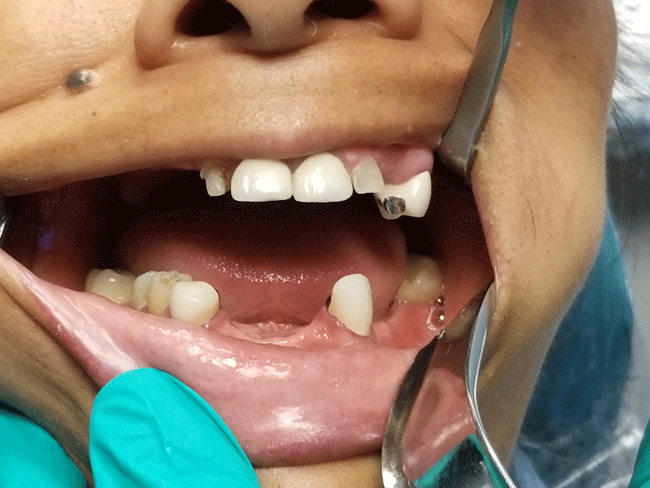1. Tooth Loss
It is difficult enough for a person to lose teeth. It can cause an extreme blow to an individual’s self-esteem, as well as, affect their overall health causing secondary effects such as cardiovascular disease, diabetes mellitus, and osteoporosis. The approaches to replacing these missing teeth include: fixed dental prosthesis, removable dental prosthesis and dental implants.

2. Why Dental Implants?
Dental implants are the most innovative way to restore an individual’s confidence and smile. Dental implants are the “most advanced way to replace missing teeth…designed to replicate the natural tooth root and crown of the natural tooth. This procedure preserves the gingival mucosa and bone with no damage to adjacent teeth.” 1
3. Past vs. Present Dental Implant Solutions
In the past, implant placement involved extraction of the diseased tooth and then having the patient wait 2-4 months for the socket of extraction to heal. The restorative dentist would then place the implant and the patient was required to wait another 3-6 months for the surrounding bone to integrate with the implant. After these 2 procedures, the patient underwent another surgical procedure to to expose the implant and then position a prosthetic abutment.1 After all was said and done, the patient had to wait upwards of 8-12 months to replace a lost tooth. Thankfully, modern medicine has made it possible to shorten the treatment and in some cases the implant can be immediately loaded with the prosthesis.
4. Immediate Implant Placement Following Extraction
Immediate implant placement is when a dental implant is placed at the exact same time that a patient’s tooth is extracted. Today, immediate implant placement has become an extremely popular procedure, performed by dentists to replace missing teeth, boost patient’s self-confidence and overall health and well-being.

5. Benefits of Immediately Place Implants following Extraction?
Evidence has shown that immediate implant placement is more beneficial to the patient vs. delaying placement. For starters, immediate implant placement reduces the need for angled abutments since the dental implants can be placed right in the fresh extraction site. Second, contaminants are less likely to affect the extraction socket when the dental implants are placed immediately. Third, immediate implant placement eliminates the waiting time for the initial healing of the soft tissues and subsequently the regeneration of the osseous structure. Fourth, Osseointegration or “a direct structural and functional connection between ordered, living bone and the surface of a load-carrying implant, is critical for implant stability” is encouraged as the bony receptors are preserved.2 Also, Immediate implant placement provides the patient and doctor “a simplified surgical workflow and subjects the patient to one surgery instead of two.”3

6. Ideal Conditions for Immediate Implant Placement
Though immediate implant placement is the quickest way to replace an individual’s missing teeth, it is not an option for every patient. It does require more time for the doctor, as well as, the fact that the patient will spend more time in the chair at the time of the surgery. An immediate implant placement patient undergoes vigilant patient screening. Ideally, the patient would have “adequate bone quality (D2 or D3 bone)” and the procedure would involve “screw-shaped implants, rough implant surface, and minimum implant length of 10 mm, adequate primary stability and avoidance of lateral forces. Primary stability of immediately placed implant seems to be the most important factor in immediate loading.”1
7. Conclusion
In conclusion, immediate implant placement can restore a patient’s smile, in turn increase confidence, ability to chew, quality of life and possibly help prevent certain secondary health effects as a result of tooth loss quickly. However, thorough screening and assurance of ideal conditions must be conducted, as well as, taking into account patient’s own emotional, medical and financial situation to ensure a successful outcome.
Sources
- Mayank Singh, Lakshya Kumar, Mohd. Anwar, and Pooran Chand. Immediate dental implant placement with immediate loading following extraction of natural teeth. Natl J Maxillofac Surg. 2015 Jul-Dec; 6(2): 252–255. URL: https://www.ncbi.nlm.nih.gov/pmc/articles/PMC4922245/#ref8
- S. Parithimarkalaignan and T. V. Padmanabhan. Osseointegration: An Update. J Indian Prosthodont Soc. 2013 Mar; 13(1): 2–6. Published online 2013 Jan 11. URL: https://www.ncbi.nlm.nih.gov/pmc/articles/PMC3602536/
- Suvi Rantanen. Immediate loading: What’s in it for the patient and practice? Nobel Biocare Blog. 2017 Dec. URL: https://www.nobelbiocare.com/blog/tips-and-techniques/immediate-loading-whats-in-it-for-the-patient-and-practice/#easy-footnote-bottom-11-3501
- Schropp L, Isidor F. Timing of implant placement relative to tooth extraction. J Oral Rehabil. 2008;35(Suppl 1):33–43. [PubMed] [Google Scholar]
- Vidyadharan A, Hanawa Y, Godfrey S, Resmi PG. Immediate implants and immediate loading in full arch maxilla and mandible of a bruxer – A case report. IOSR J Dent Med Sci. 2014;13:62–7. [Google Scholar]
- Krump JL, Barnett BG. The immediate implant: A treatment alternative. Int J Oral Maxillofac Implants. 1991;6:19–23. [PubMed] [Google Scholar]

Dr. Gregory J. Young is a Diplomate and board certified by the American Board of Oral Implantology/Implant Dentistry. He is also an Associate Fellow of the American Academy of Implant Dentistry. Additionally, he provides education, training and mentoring to his colleagues in all phases of implant dentistry. He has over 37 years of experience and dedicates his practice solely to implant dentistry and training.




